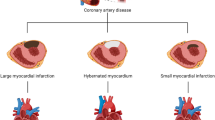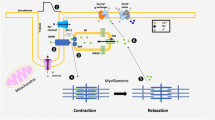Abstract
The effects of ischaemia and reoxygenation on cardiac contractile function can be abrogated by ischaemic preconditioning (IPC). We tested whether β-adrenoceptor agonists could mimic IPC and whether IPC was dependent on β-adrenoceptor activation in rat-isolated cardiac tissues. Paced left atria and right ventricular strips were set-up in Krebs solution and isometric developed tension recorded. Ischaemia was simulated by replacing with hypoxic glucose-free Krebs solution for 30 min. IPC and isoprenaline (10−7 M) preconditioning for 10 min were examined. Developed tension post-reoxygenation was expressed as a percentage of the pre-ischaemic baseline. Recovery at 15 min was significantly increased by IPC in atria (47 ± 4.0% vs. 29.3 ± 1.7%, p < 0.05) and ventricles (39.0 ± 5.2% vs. 22.4 ± 2.8%, p < 0.05). At 60 min, isoprenaline-treated atria recovery (75.8 ± 16.6%) was significantly (p < 0.05) greater than controls (47.9 ± 2.3%). Propranolol (10−6 M) abolished both effects. Therefore, both IPC and β-adrenoceptor agonist-induced improvement of contractile recovery was propranolol-sensitive and β-adrenoceptor-mediated.








Similar content being viewed by others
Abbreviations
- βP:
-
β-adrenoceptor-mediated preconditioning
- IPC:
-
ischaemic preconditioning
- Pro:
-
propranolol
References
Ahlquist RP (1948) A study of adrenotropic receptors. Am J Physiol 153:586–600
Broadley KJ, Penson PE (2004) The roles of alpha- and beta-adrenoceptor stimulation in myocardial ischaemia. Auton Autacoid Pharmacol 24:87–93
Carr CS, Hill RJ, Masamune H et al (1997) Evidence for a role for both the adenosine A1 and A3 receptors in protection of isolated human atrial muscle against simulated ischaemia. Cardiovasc Res 36:52–59
Cason BA, Gamperl AK, Slocum RE et al (1997) Anesthetic-induced preconditioning: previous administration of isoflurane decreases myocardial infarct size in rabbits. Anesthesiology 87:1182–1190
Cohen MV, Yang XM, Downey JM (2006) Nitric oxide is a preconditioning mimetic and cardioprotectant and is the basis of many available infarct-sparing strategies. Cardiovasc Res 70:231–239
Di Paola R, Cuzzocrea S (2007) Peroxisome proliferator-activated receptors ligands and ischemia–reperfusion injury. Naunyn Schmiedeberg’s Arch Pharmacol 375:157–175
Frances C, Prevost A, Moreau F et al (2003) Role of beta1 and beta2-adrenoceptor subtypes in preconditioning against myocardial dysfunction after ischemia and reperfusion. J Cardiovasc Pharmacol 41:396–405
Huang MH, Wang HQ, Roeske WR et al (2007) Mediating d-opioid-initiated heart protection via the beta2-adrenergic receptor: role of the intrinsic cardiac adrenergic cell. Am J Physiol Heart Circ Physiol 293:H376–H384
Iliodromitis EK, Tasouli A, Andreadou L et al (2004) Intravenous atenolol and esmolol maintain the protective effect of ischemic preconditioning in vivo. Eur J Pharmacol 499:163–169
Jennings RB (1996) Overview of preconditioning against lethal cell injury. In: Marber MS, Yellon DM (eds) Ischaemia: preconditioning and adaptation. BIOS Scientific, Oxford, pp 1–20
Kloner RA, Rezkalla SH (2006) Preconditioning, postconditioning and their application to clinical cardiology. Cardiovasc Res 70:297–307
Kolocassides KG, Galinanes M, Hearse DJ (1995) Preconditioning accelerates contracture and ATP depletion in blood-perfused rat hearts. Am J Physiol 269:H1415–H1420
Lange M, Smul TM, Blomeyer CA et al (2006) Role of the β1-adrenergic pathway in anesthetic and ischemic preconditioning against myocardial infarction in the rabbit heart in vivo. Anesthesiology 105:503–510
Laskey WK (2005) Brief repetitive balloon occlusions enhance reperfusion during percutaneous coronary intervention for acute myocardial infarction: a pilot study. Catheter Cardiovasc Interv 65:361–367
Lochner A, Genade S, Tromp E et al (1999) Ischemic preconditioning and the beta-adrenergic signal transduction pathway. Circulation 100:958–966
Ma G, Al-Shabrawey M, Johnson JA et al (2006) Protection against myocardial ischemia/reperfusion injury by short-term diabetes: enhancement of VEGF formation, capillary density, and activation of cell survival signalling. Naunyn Schmiedeberg’s Arch Pharmacol 373:415–427
Marais E, Genade S, Strijdom H et al (2001) p38 MAPK activation triggers pharmacologically-induced ?-adrenergic preconditioning, but not ischaemic preconditioning. J Mol Cell Cardiol 33:2157–2177
May DC, Ross EM, Gilman AG et al (1985) Reconstitution of catecholamine-stimulated adenylate-cyclase activity using 3 purified proteins. J Biol Chem 260:5829–5833
Mehta D (2006) British national formulary. The British Medical Association and The Royal Pharmaceutical Society of Great Britain, London, p 902
Moolman JA, Hartley S, Van Wyk J et al (2006a) Inhibition of myocardial apoptosis by ischaemic and beta-adrenergic preconditioning is dependent on p38 MAPK. Cardiovasc Drugs Ther 20:13–25
Moolman JA, Salie R, Lochner A (2006b) The mechanism of beta-adrenergic preconditioning (beta-PC) depends on activation of adenosine A(3) receptors by endogenous adenosine and involves the PI3-K/PKB signal transduction pathway. J Mol Cell Cardiol 41:741–742
Murry CE, Jennings RB, Reimer KA (1986) Preconditioning with ischemia: a delay of lethal cell injury in ischemic myocardium. Circulation 74:1124–1136
Nasa Y, Yabe KI, Takeo S (1997) β-Adrenoceptor stimulation-mediated preconditioning-like cardioprotection in perfused rat hearts. J Cardiovasc Pharmacol 29:436–443
Pantos C, Mourouzis I, Cokkinos DV (2006) Myocardial ischemia: basic concepts. In: Cokkinos DV, Pantos C, Heusch G, Tagtmeyer H (eds) Myocardial ischemia: from mechanisms to therapeutic potentials. Springer, New York, pp 11–27
Piper HM, Meuter K, Schäfer C (2003) Cellular mechanisms of ischemia–reperfusion injury. Ann Thorac Surg 75:S644–S648
Ravingerová T, Pancza D, Ziegelhoffer A et al (2002) Preconditioning modulates susceptibility to ischemia-induced arrhythmias in the rat heart: the role of β-adrenergic stimulation and K(ATP) channels. Physiol Res 51:109–119
Robinet A, Hoizey G, Millart H (2005) PI 3-kinase, protein kinase C, and protein kinase A are involved in the trigger phase of beta 1-adrenergic preconditioning. Cardiovasc Res 66:530–542
Schultz JE, Rose E, Yao Z et al (1995) Evidence for involvement of opioid receptors in ischemic preconditioning in rat hearts. Am J Physiol 268:H2157–H2161
Schultz JE, Hsu AK, Gross GJ (1996) Morphine mimics the cardioprotective effect of ischemic preconditioning via a glibenclamide-sensitive mechanism in the rat heart. Circ Res 78:1100–1104
Spear JF, Prabu SK, Galati D et al (2007) beta1-Adrenoreceptor activation contributes to ischemia–reperfusion damage as well as playing a role in ischemic preconditioning. Am J Physiol Heart Circ Physiol 292:H2459–H2466
Tong H, Bernstein D, Murphy E et al (2005) The role of beta-adrenergic receptor signaling in cardioprotection. FASEB J 19:983
Tune JD, Gorman MW, Feigl EO (2004) Matching coronary blood flow to myocardial oxygen consumption. J Appl Physiol 97:404–415
Vegh A, Szekeres L, Parratt JR (1991) Transient ischaemia induced by rapid cardiac pacing results in myocardial preconditioning. Cardiovasc Res 25:1051–1053
Vittone L, Said M, Mattiazzi A (2006) β2-Adrenergic stimulation is involved in the contractile dysfunction of the stunned heart. Naunyn Schmiedeberg’s Arch Pharmacol 373:60–70
Weselcouch EO, Baird AJ, Sleph PG et al (1995) Endogenous catecholamines are not necessary for ischaemic preconditioning in the isolated perfused rat heart. Cardiovasc Res 29:126
Yabe KI, Ishishita H, Tanonaka K et al (1998) Pharmacologic preconditioning induced by β-adrenergic stimulation is mediated by activation of protein kinase C. J Cardiovasc Pharmacol 32:962–968
Yates L, Mardon HL, Broadley KJ (2003) Preconditioning against myocardial stunning by beta-adrenoceptor stimulation with isoprenaline. Auton Autacoid Pharmacol 23:P7
Acknowledgement
This work was funded by a British Heart Foundation Studentship (FS-05-075-19397) awarded to P.E.P. for which the authors are grateful.
Author information
Authors and Affiliations
Corresponding author
Rights and permissions
About this article
Cite this article
Penson, P.E., Ford, W.R., Kidd, E.J. et al. Activation of β-adrenoceptors mimics preconditioning of rat-isolated atria and ventricles against ischaemic contractile dysfunction. Naunyn-Schmied Arch Pharmacol 378, 589–597 (2008). https://doi.org/10.1007/s00210-008-0331-6
Received:
Accepted:
Published:
Issue Date:
DOI: https://doi.org/10.1007/s00210-008-0331-6




